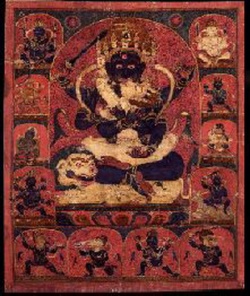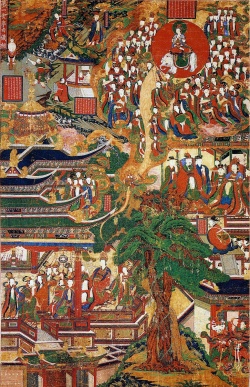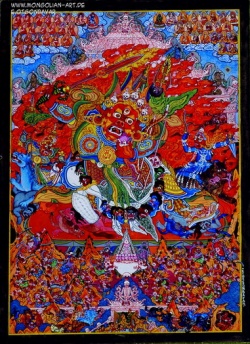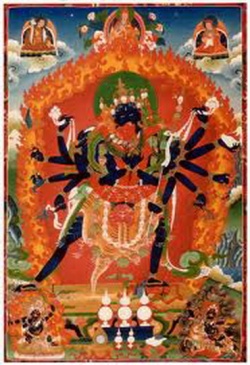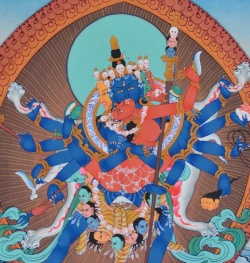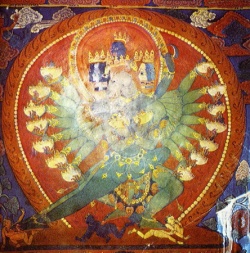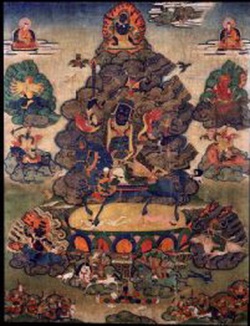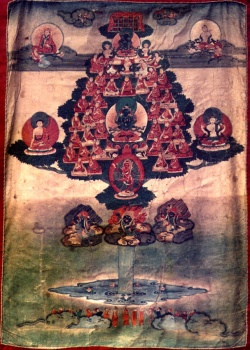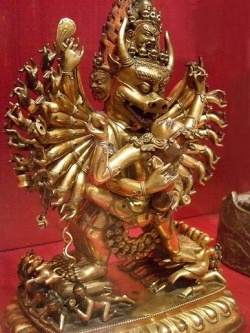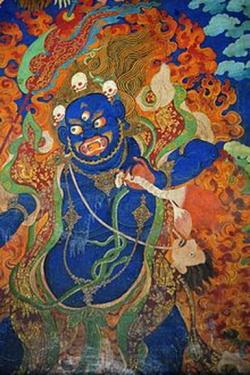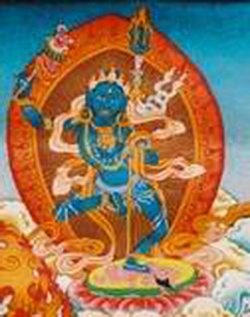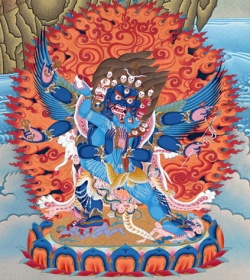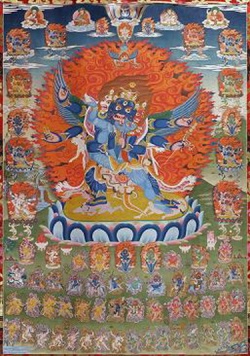The Mythology of Tibetan Mountain Gods: An Overview
by Xie Jisheng
==The Tibetan Mountain Gods==
There are countless high mountains in Tibet, and ancient Tibetans believed that Gods resided on every one of them. The worship of mountain Gods was one of the most important forms of nature worship among ancient Tibetans; it was fundamental to their entire belief
system. Each mountain God possessed his own territory and was in charge of particular affairs. Around each God sprang up myths, legends, sacrificial rites and procedures. Analysis of Tibetan mountain God worship should lead to a fuller understanding of Tibetan mythology, and to a vision of the larger structures of that mythology.
As ancient Tibetan society grew ever more complex, individual, autonomous Tibetan mountain Gods became associated in a complex hierarchy. Classification and stratification heralded the emergence of a single, supreme Deity. Different geographical circumstances, and complex social developments and contradictions in the Religion, however, brought about similarities, differences, and contradictions in characteristics and functions among the Deities in the upper echelons of the system.
According to traditional, pre-Buddhist Tibetan belief, there are four
great mountain Gods in the Tibetan region; each one is identified with a specific sacred mountain : yar-lha-sham-po in central Tibet; gnyan-chen- thang-lha, in Byang-thang in the north; sku-lha-ri-rgya in the south; vod-de- gung-rgyal in the south. These four Gods, together with five other famous mountain Gods—rma-chen-spon-ra (or Anyesrmachen), shyogs-chen-ldong- ra, sgan-po-lha-rje, zhogs-lha-rgyug-po, and shevu-kha-rag—Form the core
1 The four great Sacred mountains in Tibetan Buddhism—
lcogs-po-ri, mgon-po-ri, hos-po-ri, and dkar-po-ri—differ from those named here.
of the Tibetan mountain-God system; together they were called “the nine creator-Gods” (srid-pa-chags-po-lha-dgu). In addition, geographical differences between each Tibetan region gave rise to individual local Gods, such as the great mountain God gnyan-po-g’ywu-rtse-rdza-re, worshipped by the Tibetan go-log tribe, and the sacred mountain of gangs-dkar-ti-se in western Tibet.
The study of Tibetan mountain Gods presents two principal problems.
First, previous research on Tibetan mythology has had little to say about them, and what data does exist is quite heterogeneous. In addition, the features of the myths have certainly been diluted over time. Buddhist myths and Rituals muffled the original character of the Tibetan myths; for example, almost all mountain Gods are now Buddhist guardians. These twin obstacles require that our Investigation must start
with the place of mountain Gods in relevant folk beliefs, myth, Ritual, and customs. Some Tibetan literature and Ritual scriptures also help to reveal the outline of the involved mythology. In what follows, all these sources are employed in providing an introduction to and analysis of some well-known mountain God myths and Rituals.
The Myth of yar-lha-sham-po
Located in the vphyongs-rgyal county, yar-lha-sham-po “the great God sham-po,” ranks second among the nine creator-Gods mentioned above, behind only the mountain God [[vod-de-gung-rgyal. Yar-lha-sham-po is an old mountain God, often mentioned in the classic Tibetan scriptures of Dunhuang from the sixth to the ninth centuries CE. The scriptures
state that “yar-lha-sham-po is the highest God” (Yar-lha-sham-po-ni-gtsug-lha-vo),2 but, in fact, yar-lha-sham-po is not the highest mountain peak in Tibet; it is, rather, largely due to its location in central Tibet that it became one of the greatest Tibetan Gods.
The Tibetan mountain Gods belong to two principal classes. One
arose from the deification of mountains believed to act as the benefactors of mankind. Such mountains are most often located in proximity to temperate valleys and fertile pastureland that benefit from the reservoirs of water held in the snowy mountaintops. The natural
advantages conferred by the fertile land and mountain waters led the local inhabitants to deify the snowy mountains, creating mountain Gods. These Gods, obviously, were seen as benefactors of mankind. The other major class occupies mountains located in dense forests or in wild and desolate lands uninhabited by mankind.
2 Wang and Chen 1980:98, 102.
These Gods are usually considered to be Evil. Yar-lha-sham-po is located in the Yar-lung River Valley, an agricultural region said to be the cradle of the Tibetan people. The material bounty that nature afforded the ancient inhabitants of this river valley induced them to deify the surrounding mountains, and yar-lha-sham-po was
venerated as the greatest God. With the later interaction and amalgamation between the Yar-lung tribe and other tribes, the Yar-lung developed and prevailed, eventually becoming the rulers of the entire Tibetan people. Their principal mountain God, consequently, became the principal God for all Tibetan tribes.
In Tibetan historiography, the mountain God yar-lha-sham-po is often called the royal God, and represents the Power of the royal family. At the beginning of the spread of Buddhism into Tibet, many members of the royal house, adherents of the native Tibetan Religion, Bon-po, remained averse to Buddhism. This situation gave rise to the story of how the Buddhist Deity
pad-ma-vdyung-gnas encountered resistance from yar-lha-sham-po, who caused a flood to destroy a Buddhist palace. The emergence and triumph of yar-lha-sham-po as the supreme mountain God is also the history of the development and strength of the yar-lung tribe.
Absent a unified Tibetan Power and a wise king skilled in military strategy, the Tibetan mountain God yar-lha-sham-po would not have become such a preeminent fixture.
A distinctive feature of Tibetan mythology is that the images of mountain Gods are based on religious elements other than the physical mountains themselves. They are often embodied as Animals or totems. In this respect the mythology is not one-dimensional
but exemplifies complex forms. A good example is the image of yar-lha-sham-po. According to a popular regional myth, yar-lha-sham-po is portrayed as a white yak, from whose mouth and nose snowstorms continuously blow. He is endowed with
extraordinary magical powers: he can destroy rocks, cause floods, and even transform himself into a white man in order to have sexual intercourse with women and father babies. As the paramount God, yar-lha-sham-po ruled all local Gods (yul-lha) and village Gods (sa-bdag) in the Yar-lung region. Here is a description of yar-lha-sham-po in the throes of resisting pad-ma- vbyung-gnas as the new God tries to enter Tibet:
de nas. o rgyan Padma vbyung gnas kyis
lha vdre gdug pavi zhe bstags mkhyen nas su bal yul lam vphrang lam na gshengs tsa
Yar lha sham povi skungs thog brgyab
g. yag dkar ri tsam zhig tu sprul
vus vdebs brag rnams thams cad rlog
lam vphrang bcad nas vgro sa med par byas kha rlang sna rlang ma bun bzhin du vthids
[[kha char babs pas lam mi mthon] bar byas]]
After that, master pad-ma-vbyung-gna
Knew beforehand that it was time to defeat the monster, Came to the dangerous road of lam-vphrang.
Yar-lha-sham-po sent out ambushing thunders.
He turned into a white yak as large as a mountain, Became wild and smashed rocks,
Blocked the road and left no passage;
Air pumped from his mouth and nostrils as dense as fog-fall;
It was heavy with rain and snow that let you see nothing of the road.
The portrayal of yar-lha-sham-po—as a white yak who can change shape at will—reveals something of early Tibetan beliefs about mountain Gods. As the myths about the mountain developed, images of yar-lha-sham- po also changed; a white yak was replaced by a man-God clothed in white with a Body as white as a Conch, holding a short spear with colorful silk flags and a crystal sword in
his hands. This human image of yar-lha-sham- po is typically accompanied by a wife and children. His wife is gnam-sman- thog-gi-bu-yug, the primary Goddess. She is clothed in Light red attire, holds lightning in her right hand and hailstones in her left, and flies on bolts of lightning.
The Myth of gnyan-chen-thang-lha
If yar-lha-sham-po is the supreme God, indeed the royal God, then the most famous mountain God is gnyan-chen-thang-lha; he is also known as thang-lha-val-shur or thang-lha-yab-shur. Gnyan-chen-thang-lha was first worshipped as a God of hail, one of eighteen Deities in charge of hail. When people passed by the mountain thang-lha, they would burn Incense and offer all kinds of sacrifices to him.
In Tibetan mythology gnyan-chen-thang-lha is a guardian of treasure. A prayer text describes the image and lineage of this mountain God: sku lhavi yab smos pa vo de gung rgyal lags sku lhavi yum smos pa g.yu bya gshog gcig sku lhavi nyid smos pa
yar zhur gnyan gyu lha
3 Tong 1985:18a-18b.
bzhugs yul mtshan gsol ba vdam shod snar mo lags
khri rges g.yu ljang vkhril dbyar sngo dgub yang sngo
bzhugs yul nyams re dgav
dgyes so lha yi yul mi chos mtshan gsol ba thang lha ya zhur lags
lha chos mtshan gsol ba dri zavi rgyal po ni
gsang bavi mtshan mtshan gsol ba
zui phud lnga pa lags sku lha ci gsol ba
rdo rje vbar ba rtsal
dar dkar ras dkar gsel chibs su ci chibs na
lha rta rkang dkar chibs
knams gsum kun du rgyu mdog dkar vod zer vbar g.yas na spa cags vphyar ma kun las la vgye
g.yon pa shel vpheng vdren
To your father
vod-de-gung-rgyal pray. Plead to your mother,
The single-winged jade bird. To yourself,
God yar zhur gnyan gyu, pray.
With respect I mention your residence,
vdam shod snar mo lags.
An eagle as green as turquoise is soaring in between. It is full of Light there,
Though in winter it is as green as spring.
O mountain God, the land you inhabit is delightful! I call upon your name, and your name is known to
the Gods,
The heavenly musician king mtshan gsol ba. I call upon your secret name,
rdo rje vbar ba rtsal.
O mountain God, what Clothes do you wear?
You wear white, a silk dress and a white cotton coat.
If you want to ride, what are you going to ride, mountain God? You ride on a magic Horse with four white hooves,
Galloping across the three worlds. Your white dress sends out brightness. You hold a cane in the right hand
And hold a crystal rosary in the left.
The text Padma-bkav-thang describes how the Buddhist God pad-ma-vdyung-gnas, who came to Tibet to spread Buddhism, defeated monsters and Gods. Note the mention of gnyan-chen, here called thang-lha:
de nas sku gnyan thang lha nyams sad phyir mgo bo gru guvi yul du sleb pa la
gzhug ma khams kyi sog chu gyer thang brkyangs sbrul dkar zhig gis lam vphrang bcad pa la
slob dpon sbrul gyi sked par phyag vkhar btshugs
klu yi rgyal po ne le thod dkar khyod dri zavi rgyal po sur phud lnga pa zhes
khyod rang phar song tshags vkhor shoms dang gsungs
thang lhas gangs la bros pas gangs zhu nas rtse mo nag zang g. yav sngon nyil gyis byung ma bzod zhal zas sna tshogs vkhor drangs
byis pa gyu yi zur phud can du gyur
dar dkar ral gu zhig gyon phyag bskor byas srog suying phul nas dam btags gter rgya gtad
gsang mtshan rdo rje mchog rab rtsal du gsol4
At this time, sku-gnyan-thang-lha is the testing master. He stretches his head to the region of gru-gu;
His tail fills up the possession sog-chu-gyer-thang.
A white snake blocks the road,
The master puts the stick onto the waist of the snake, and says: “You are the Dragon King ne-le-thod-dkar,
dri zavi rgyal po sur phud lnga pa zhes.
Be quick and return to prepare the tshags Offerings and dang city.”
Thang-lha runs to the snowy mountains that are melting. The black peak appears,
Green rocks crash down.
Thang-lha cannot bear such hardship,
Offers all kinds of delicious Food for the dang city,
And is transformed into a boy-waiter wearing jade, his Hair in a bun, Wearing a white dress as a sign of the Lotus.
He takes a vow to offer his Life for the sake of Buddhist scriptures, Prays and gets the secret name of rdo-rje-mchog-rab-rtsal.
The prayers for the mountain God gnyan-chen-thang-lha contained in this folk Ritual book reveal more detailed mythological data: gnyan-chen is the son of the mountain God vod-de-gung-rgyal and the single-winged jade bird, and is the chief of the gnyan Gods. The place where the God lives is called vdam-shon;5 the jade-green bird brings vitality and the greenness of spring even to the snowy mountains in wintertime. In popular mythology gnyan- chen-thang-lha is imagined as a white man.6
The prayers quoted above describe him as the heavenly musician zui phud lnga pa, a detail that clearly alludes to the influence of Buddhism. In Tibetan drawings, zui phud lnga pa is often drawn as a handsome man attired in white, his Hair tied up in five turquoise-colored buns. According to these images, the mountain God gnyan-chen-thang-lha is a white
man astride either a magic Horse with four snow-white hoofs or a flying white Horse. In his right hand the God holds a cane or a crystal sword. In some folk traditions, however, gnyan-chen-thang-lha is still a ferocious hail God to whom people are obliged to make blood-Offerings and sacrifices of mules, horses, and sheep.7 The God also
4 Padamsambhava 1988:363-64.
5 I suspect that vdam-shon should be vdam-gzhung, which is located east of the middle part of the gnyan-chen-thang-lha mountain.
6 See further Editorial Board 1983.
possesses great powers of transfiguration and can become a gigantic monster as large as a mountain; he can even change into a big monkey. On the south end of gnyan-chen-thang-lha there is a famous lake called gnam-mtsho, and the herdsmen in North Tibet believe that the Goddess in the lake is the wife of this mountain God.
The Mythology of the Mountain God Anyesrmachen
The Anyesrmachen Mountain is a range at the southern end of Kukunor. In Tibetan, it is known variously as rma-chen-spon-ra, rma-rgyal-spom-ra , ram-gnyan-spon-ra , and ram-ygyal; locally, it is called anyesrmachen. In Tibetan mythology, anyesrmachen is a great God who lives in the east; his worship is particularly widespread in the pastoral region of mdo-khams, an area also known for the prevalence of the Gesar epic. In fact, the mountain God anyesrmachen plays a key genealogical role in the epic. In the passage
telling how King Gesar’s mother klu-mo-vgog-mo Dreams of a yellow man (mi-ser-po) who has sex with her, with the result that she later gives birth to Gesar, the yellow man is in fact the mountain God anyesrmachen.8 The Gesar epic also explains that the mountain God can
make the yak and the mare fertile and can strengthen other Animals. The snowy waters of anyesrmachen, guardian of mankind, can cure diseases such as leprosy.
Although textual research into the early iconography of anyesrmachen is not possible, some traces of it may be seen in an old song popular in the Amdo region:
Stod rma rgyal ri la mgo yod ki mgo yod na klad pa yod med shod Stod rma rgyal ri la sked yod ki Stod rma rgyal ri la Lto yod ki
Lto yod na rgyu ma yod med shod Stod rma rgyal ri la mgo yod gi mgo yod na klad pa los re yod gangs gkar bo babs na klad pa red Stod rma rgyal
ri la sked yod ki sked yod na ske rags los re yod
sked smug pas bzung na ske rags red
7 Qinghai 1958:48.
8 Qinghai 1959:49.
stod rma rgyal ri la lto yod ki lto yod na rgyu ma los re yod
sbrul khung la vdzul na rgyu ma red
Is there a head for the upper rma-rgyal mountain? If there is, is there any brain?
Is there a waist for the upper rma-rgyal mountain? Is there a belly for the upper rma-rgyal mountain? If there is, are there any bowels?
The upper mountain rma rgyal has no head. If it had a head, it should have a brain.
The falling snow is the brain.
The upper mountain rma rgyal has a waist.
If it has a waist, there must be a belt to tie it up. The clouds and fog in the mountains are the belt. The upper mountain rma rgyal has a belly.
If it has a belly, it must have bowels.
The poisonous snakes going into their holes are the bowels.
In the the ancient song, the images of the mountain God are extremely unstable, and his appearance as nature God is the most prevalent aspect of his presentation. However, in Buddhist Ritual texts, the mountain God is described as wearing armor and a white fighting gown studded with decorative gems. He is often pictured waving a spear with a fixed flag in his left hand, while holding a magic bowl full of gems his right hand. Around one of his upper arms is wrapped a bag made of eagle-skin (nevu-levi-rkyal-pa). He rides a magic Horse that gallops as fast as a cloud.
His wife is the Goddess rma-chen, also known by the names gung- sman-ma and rma-ri-rab-vgyams rdo-rje-dgra-mo-rgyal, and she has her own extensive mythology. She originally lived on the anyesrmachen mountain and was considered the greatest of the twelve Goddesses (bstan- ma-bcu-gnhyis). Tibetan Ritual texts describe her in this way: she rides a stag as white as a
Conch, and her Body is as white as the snowy mountains. She is extremely beautiful, and her Hair is plaited with colorful ribbons. In her right hand she holds a magical mirror, in her left a lasso and an iron hook. Dressed in a silk coat, she is adorned with a golden crown decorated with diverse gems atop her head. She also wears a pearl necklace, bracelets, and anklets; a shining Bell is fixed to the belt around her waist.
A Tibetan prayer gives another description of rma-chen:
You look with angry Eyes, Riding on lightning,
Spitting Fire-like clouds from your mouth,
Spewing smoke from your nostrils,
Fire clouds are enshrouded behind you. You instantly gather clouds in the sky,
With thunder roaring across the World in all the ten directions. On the road to Death it is full of meteors
And big hailstones,
The foundation of the Earth is swollen by water and Fire, Evil birds and crows are flying in the sky,
Yellow birds with yellow beaks came down from the air.
The Goddess sman-mo tucks herself up into a ball, Many monsters appear;
The praising God’s Horse dashes here and there.
If you like,
The seawater can connect itself to the blue sky; If you hate,
Even the sun and the moon will fall to the dust; If you laugh,
The mountains of the World will even crumble to dust.9
This text clearly shows that rma-chen was originally a hail Goddess, who rides lightning and spews forth clouds of Fire from her mouth and nostrils. However, the myth also describes her as a beautiful woman, richly decorated with jewelry, a contrast that points to the ambiguity of her nature. Together she and any esr machen have nine sons, who are often depicted riding tigers, and nine daughters, who ride cuckoos.
Among the nine creator-Gods, the mountain God anyesrmachen customarily ranks fourth, though some traditions place him fifth. He is the brother of yar-lha-sham-po and gnyan-chen-thang-lha, among others, and the eighth son of vod-de-gung-rgyal. Vod-de-gung-rgyal, also called srid- pavi-lha-rgan, is the founding father of the Tibetan mountain Gods. He is an
ancient Tibetan God who inhabited a palace decorated with rare stones on a steep and snowy mountain. According to a myth popular in the Amdo region, vod-de-gung-rgyal was an old man who lived near Lhasa. He had eight nomadic sons who lived by Hunting. One day while out Hunting, the old man met large groups of refugees fleeing from monsters that had appeared in Duo Kang. They asked the old man to vanquish them, and he dispatched each of his eight sons to one of the locations haunted by the monsters. The fourth son went to Amdo. After defeating the monsters, a nine-story crystal palace was built for them. When the sons met up with their father, the crystal palace became the huge and snowy Anyesrmachen
Mountain.
An eastern extension of the Bayakhara Mountain, gnyan-po-g’yu-rtse-rdza-ra is also known as sngo-la-g’yu-rtse or gnyan-rje-sngo-la-g’yu-rtse. It is particularly sheer, and is further distinguished by its many sharp rocks. The Tibetan go-log tribe lives around this mountain, thus providing its alternate name, “go-log Mountain.” According to Tibetan Ritual texts,
gnyan-po-g’yu-rtse-rdza-ra lives in a large palace, inside which a red storm blows endlessly. The roof is made of gold and turquoise in the Han style, and the palace is
surrounded by iron mountains where many ferocious beasts live. Seen from the outside, the palace appears as a gray Horse, on whose back the great gnyan-po-g’yu-rtse-rdza-ra himself rides.
In the standard iconography, this mountain God wears burgundy clothing under his armor, holds an iron hook in his right hand, and girds a quiver around his waist. His wife, gnyan-ma-ma-le-gu, is dressed in white; she holds an arrow tipped with brilliantly colored feathers and rides on a red doe. The son of gnyan-po-g’yu-rtse-rdza-ra is named tho-ri-rgyal-ba; traditionally garbed in a pink gown, he holds a long spear and a lasso and rides on a blue dragon. Gnyan-po-g’yu-rtse-rdza-ra also has two assistant Gods, the fast and hot-tempered ston-hor-bovi-sras and the young and beautiful Goddess lha-sman-sras-mo.11
There is a famous myth in the go-log region about gnyan-po-g’yu- rtse-rdza-ra. A young man named che-ambum once came from the ngarlatu region, where he had saved a young dragon caught by an eagle near the Wagn-tsho and Daitso lakes. After this deed, he met several people coming from the lake; one wore white, the others either blue or yellow. These men, who were in fact incarnations of lesser mountain Gods, told him that the dragon he had saved from the eagle’s beak was the youngest son of the mountain God gnyan-po-g’yu-rtse-rdza-ra. Afterwards
the mountain God gave che-ambum a stick adorned with six-colored ribbons, which the young man used to woo the mountain God’s third daughter and take her as his wife. Their offspring were the ancestors of the go-log tribe.12
The Myth of the Five Sisters of Longevity
The myth of the Five Sisters of Longevity (tshe-ring-mched-lnga) is popular in the Mount Everest region. The five sisters are identifed with particular mountains in the area. The greatest of them is bkra-shis-tshe-ring- ma, who oversees the welfare and longevity of mankind. Iconographically, she is young and beautiful, and rides a white lion. In her left hand
she holds a sacred arrow used for taking auspices; dice made of white Conch and a cloak made of Peacock feathers, and a white scarf wrapped around her head.13 Bkra-shis-tshe-ring-ma belongs to a group of guardian Goddesses who offer cleverness and Wisdom to mankind. Among the sisters of longevity are mting-gi-zhal-bzang-ma, typically represented as a
green Goddess holding a magical mirror and riding a wild Horse; the yellow Goddess mi-g’yu-blo-bzang-ma, a giver of grain who rides a golden tiger; the red Goddess cod-pan-mgrin-bzang-ma, a Goddess of Wealth who holds a plate full of treasures and rides a red doe; and another green Goddess, gtad-dkar-vgro-bzang-ma, who
holds a sacred arrow in her hand, rides a dragon, and possesses dominion over the Animals. The Five Sisters of Longevity live on the peak of Mount Everest. Myth tells that at its foot lie five icy lakes, each a different color corresponding to the colors of the five Goddesses.
The Eminence of the Mountain Gods
In Tibetan mythology, the mountain Gods have immense Power and rule all other Deities; this Power stems from their control of weather Phenomena—the wind, the clouds, thunder, hail, and so on. Accordingly, they have become the principal Gods of Tibetan mythology, and their veneration is the most important Form of
nature worship in Tibet. In this regard Tibetan mythology is no different from myths of peoples all over the World, since the principal Gods in most cultures are usually nature Gods. Because of their massive “bodies” and because of the Illusions created by the weather around the peaks, mountain Gods have changeable images
in Ritual. In time an amalgamation of mountain God worship with animal worship occurred: Animals such as sheep, yaks, and wild horses all but replaced the old images. This animal imagery in turn gave way to anthropomorphism, as the animal forms became accompanying Gods or the beasts that the mountain God rides. Changes in Ritual imagery notwithstanding, the preeminence of the mountain Gods in Tibetan mythology is unquestioned. Sacrifices to them are a collective rather than an
individual matter, for a mountain God is not usually considered to be an individual guardian; instead, he or she is the guardian of a particular tribe or even an entire people.
The Mountain Gods and the Heavenly Rope
The Origin, Development, and Etymology of the Heavenly Rope
Owing to the lofty heights of the mountains and the sometimes illusory Influences of weather conditions, ancient Tibetans connected the mountain Gods to the more abstract conceptual class of heavenly Gods, believing the peaks to be sites for passage from this World to the heavens above, sites where a rope (or step) was connected directly to Heaven.14
Myths about this heavenly rope (dmu-thag in Tibetan) were, not surprisingly, especially prevalent among the various ethnic groups that lived near the mountains themselves.
14 Similarly, La Farque notes that “the Australian aborigines believe that the soul climbed up a rope to reach a hole in the Heaven where it entered another World” (1978:132).
Gods: heavenly Gods were chiefly symbolic and less directly connected to the material Life of early Tibet. Over time, however, the apparent physical proximity, together with similarities in Ritual worship, led to increased identification between the mountain Gods and the heavenly Gods, the result being that the latter now possess a large measure of the features of the preeminent mountain Gods; it is even held that mountain Gods and heavenly Gods can transform from one into the
other. The mountain Gods sometimes rise to the status of heavenly Gods, and the heavenly Gods sometimes descend to become mountain Gods. Vod-de-gung-rgyal, for example, is a patriarchal God ranked among the so-called “nine creator-Gods.” However, judging from the word vod-de-gung-rgyal, this mountain God is also a heavenly God, for in Tibetan, gung means “Heaven,” and gung-rgyal signifies “Heavenly King.”
Here it may be appreciated that the way the Tibetans understand the heavenly Gods is somewhat different from that of peoples who live in other geographical conditions. The Tibetans’ understanding of the heavenly Gods developed on the basis of their mountain God worship. After developing the conception of the heavenly Gods
through this kind of worship, ancient Tibetans postulated a tie between the two sets of Gods. Hence the myth of the heavenly rope.
The phrase for “heavenly rope” in Tibetan is dmu-thag-smu-thag.
The word dmu appears relatively late in Tibetan literature. Dmu is written as mu in Dunhuang literature, and etymological comparisons between various Tibeto-Burmese languages strongly suggests that mu- in Tibetan refers to “the heavenly God.”15 As for the word dmu-thag, I believe it to be closely connected to the Tibetan word for “rainbow” (vjav). A rainbow could well be understood by early societies as a rope connecting Heaven to Earth, a rope sent down by the heavenly Gods.
Literally, dmu-thag means “the heavenly Gods’ rope.” According to Tibetan literature, when the Tibetan king btsan- po died he looked like a rope under the “rainbow,” and he went up to the heavens along the dmu-thag . It seems, then, that there is an intimate relationship between dmu-thag and vjav. In Pelliot’s Tibetan text no. 126.2 (“The Formation of Dmu-thag”), we read that “from the lights in the sky and
15 E.g., the Kachin word mu refers to “the Heaven, thunder, and lightning,” and the Nu word mu refers to “the Heaven.” Cf. Benedict 1980:156. Also, Professor Huang Bufan has provided me with an in-depth analysis of the word dmu, showing how mu changed into dmu or rmu, as well as given me S. W. Cobin’s paper A Note on Tibetan (mu) for reference. I here express my thanks.
fog over the sea came the white curdle of the Bon Religion. It is stretched by the wind, woven into threads, and wound round a tree. It is known as Dmu-hag or g.yang thag (“Fortune rope”).”16 This text clearly identifies dmu- thag with the rainbow.
The Myth of the Heavenly Rope and the Royal Genealogy of Ancient Tibet
Like the Hans, the Tibetans also have their own tradition of historiography. beginning in the seventh to ninth centuries CE and continuing for more than 1000 years, Tibetan culture produced a wide variety of historical texts. The Tibetan historiographical tradition is closely linked to the cultural exchanges between the Tibetan
and Han peoples; as early as the sixth and seventh centuries, Tibetan scholars were translating Chinese historical texts into the Tibetan Language.17 Chronological texts similar to those in Chinese also began to appear. In much the same way that Han historians historicized their ancient mythology, Tibetan historians,
when recording their own ancestral deeds and the genealogy of the royal family, historicized Tibetan mythology, but the historiographical methods, approaches, and processes they adopted differed somewhat.18 It will be useful to turn now to an analysis of the historicizing of Tibetan mythology and its relation to the mythology of the heavenly rope.
At an early stage of the heavenly rope myth, Gods that traveled between the Heaven and the Earth appeared largely in a natural shape, taking the Form of such Animals as yaks and wild horses; etiologically, then, these
16 Karmay 1975:210. In addition, some shamanistic groups also believe that their sorcerers can ride rainbows and ascend to the heavens. They use red and blue ribbons to symbolize rainbows. Some scholars hold that the red and yellow silk ribbons that hang on the frames of the thang-ka icons (called vjav-ser and vjav-dmar in turn) are reflections of this idea, the ribbons standing for the rainbow on which the sorcerers ride.
17 Translated into Tibetan were Shangshu, Zhangguoce, and other important texts. See further Huang 1987.
18 Scholars all agree that the lack of mythology among the Han people “is largely due to historicization of the mythology in the Shang and Western Zhou Dynasties. As to the reasons for such historicization, on one hand ‘devious Gods’ were not acceptable in the Confucian Thinking of the Zhou and Han periods, and deliberately justified the Mysterious mythology. On the other, this was also an unavoidable trend of humanism and revival of arts between late Spring and Autumn period and that of Warring Kingdoms” (Zhang 1983:283). See also Yang 1992:120-40.
Animals were considered to be descended from the heavens. According to the myth known as The Horse and the Wild Horse, for example, the Horse lived in the heavens and the wild Horse lived in the middle air, and they descended to the divine land of gong-thang. With the emergence of more complex societies, anthropomorphic Gods with
magical powers replaced animal-shaped Gods. In Tibet, the currents of military and economic development fostered the emergence of a “high” culture, and people began to keep track of their ancestral history. In a system rooted in tribal confederacies, the concept of consanguinity meant that
Tibetan historiography gave special attention to the recording of genealogies. New cultural contacts also played a part. Tibetan historians employed new chronological methods, recording folk tales and myths as history with extreme rigor and accuracy. They ranked mythological figures among their ancient
kings and thus brought them into the historical record. As a result, many Tibetan history Books hold that the first generation of Tibetan kings (btsan-po) descended from the heavens to the Sacred mountains. For example, in Tibetan Historical Texts in a Duhuang Version we find that nyag-khri-btsan-po descended to the mountain of lha-ri-byang-mtheo (“the
sacred mountain towering high in the north”).19 In sum, the inheritance of royal Tibetan genealogy in ancient times was founded on the basis of the mythology surrounding the mountain Gods; indeed, the mountain Gods were crucial to the development of the heavenly Gods and the mythology of the heavenly rope.
Changes: gnyan and the Conception of the [[ Mountain Gods
Many names of mountains and mountains Gods in Tibet contain the word gnyan (“argali,” or wild sheep), the most famous being gnyan-chen-thang-lha and lha-chen-gnyan-rje-gung-sngon. The gnyan grazed in pasturelands where the ancient Tibetans often hunted it and other Animals for Food; it is here that the gnyan entered the Tibetan Consciousness. The gnyan was traditionally renowned for its fierce temper and resistance to domestication; as a result, it was often killed by ancient Tibetans,
and its horns, known as gnyan-raw, were used as vessels for wine and milk. Alongside this practice, they also worshipped the gnyan and other Animals that they hunted; such worship was born out of fear, for the gnyan was a ferocious beast. Padma Tibetans, for example, tell the following tale: On the
19 See further Karmay 1992.
mountain where they lived there was a snow-white argali. People in Wen County were very much afraid of it, because whenever it heard a human voice it would come out and kill people.20 This tale, and others like it, express the ancient Tibetan view of the gnyan as a demon. The ubiquity of the gnyan made it one of the most
important such creatures; thus the semantic extension of gnyan to include “demon” or “monster.” Inasmuch as demons were considered divine—coupled with the frequent movement of the argalis on the wild mountains and valleys that contributed to their mystery and sanctity—the gnyan was regarded as a mountain Spirit. In the
Dunhuang written text PT 986, for example, the Chinese for “mountain God” was translated as ri-gnyan-po. Other literary and historical writings support the translation of gnyan as “mountain God.”
In accordance with the Evolution of ancient Tibetan beliefs, the idea of
gnyan as a divine demon and Spirit diversified. The World of Ghosts and Gods was projected from the pattern of human social relations, further complicating the concept of the divine demon. The gnyan of mythology was eventually marked by opposing conceptions of the animal as both demon and God. The gnyan also became a totemic animal for Tibetans.
On the whole, then, it may be appreciated that the concept of the divine gnyan initially evolved from the worship of the biological gnyan, and was assoicated mainly with mountains Gods or Spirits. This divine association has also changed, and the idea of the gnyan-as-demon became more generic and widespread. The word gnyan now represents any number of different demons:[[
sa-gnyan earthly demon chu-gnyan water monster shing-gnayn wood Ghost rdo-gnyan stone Spirit brag-gnyan rock Spirit mtsho-gnyan lake Spirit
Depending on the material Form, these demons and Spirits took on new physical Appearances. For example, sa-gnyan is a frog with a jade breast; this is because the frog represents a dragon God under the ground.
Since the gnyan is such a widespread and diversified demon-God, it is believed to exist virtually everywhere. It is found not only in the substances of all inanimate objects but also in human bodies; in general, it permeates
20 Padamsambhava 1988:29, 117-18. I have seen a specimen of an ancient argali, which is genuinely frightening. It was large in stature, standing as high as two meters having horns one meter in length.
every aspect of human Life. When the demon gnyan enters the Body, it causes diseases; in Tibetan, gnyan can also mean “disease.” Of the some eighteen kinds of gnyan illnesses the following group is but a representative sample:
gnyan-kha tetanus gnyan-kha-med nephritis gnyan-vbur hot-treatment
gnayn-vbars focus of infection gnyan-glang enterogastritis gnyan-dug blister treatment gnyan-dug poison treatment
gnayn-rims seasonal febrile disease
In turn, substances in Tibetan medicine that can curb gnyan invasions incorporate the very word in their names: e.g., Saussurea involucrate is gnyan-thub-pa (anti-gnyan) in Tibetan. Musk and sman-chen are gnyan- gsod ( gnyan-killer). From these interconnections between the Spiritual and the medicinal, the developing Knowledge of diseases and medicine among the ancient Tibetans may be glimpsed.21
Institute of Nationalities Chinese Academy of Social Sciences Trans. by Naran Bilik
References
Benedict 1980
P. K. Benedict. An Introduction to Sino-Tibetan Languages. Trans. by Le Saiyue et al. from English into Chinese. Unpublished translation, deposited in the Institute of Ethnology, Chinese Academy of Social Sciences. (In Chinese).
21 The demonic and disease-causing gnyan represents the Evil aspect of its nature. This Evil aspect of gnyan, particularly its cruelty and ferocity, gradually motivated the formation of postnominal adjectives. For example, sa-cha-gnayn-po means “very dangerous,” bkav-gnyan-po means “a harsh order,” dam-tshig-gnyan means “heavy oath,” and gnayn-sa means “dangerous place.”
Editorial Board 1983 Editorial Board, eds. “Nam Hu de Chuanshuo” (“A Lengend of Namu Lake”). Bang-jin-mei-duo, October 15. (In Chinese).
Huang 1987 Huang Bufan. “Primary Research on the Four Pieces of Ancient Tibetan Translations.” Language Studies, 1:112-
25. (In Chinese).
Karmay 1975 Samten G. Karmay. A General Introduction to the History and Doctrines of Bon. Tokyo: Toyo Bunko.
Karmay 1992 . “A Pilgrimage to Kongpo [[Bon]-ri]].” Tibetan Studies,
527-40. Narita: Proceedings of the Fifth Seminar of the
International Association for Tibetan Studies. (In English).
La Farque 1978 La Farque. The Origin of Thought. Trans. into Chinese by Wang Ziye. Beijing: Shenghuo-Dushu-Xinzhi Joint Publishing House. (In Chinese).
Mgo-log 1985 The Mgo-log Prefecture Association of Writers and Artists, ed. Selected Folk Tales of the Mgo-log Tribe. Internal Reference Prints. (In Chinese)
Nebesky-Wojkowitz l975 Rene de Nebesky-Wojkowitz. Oracles and Demons of Tibet: The [[Cult}} and Iconography of the Tibetan Protective deities]] . Graz, Austria: Akademische Druck-u. Verlagsanstalt.
Padamsambhava 1988 Padamsambhava. Padma bkav thang. Chengdu: Sichuan
Nationalities Publishing House. (In Tibetan).
Qinghai 1958 The Qinghai Society for the Studies of Folk Literature and Arts, ed. Xue shan shui jing guo. Vol. 1. Xining: Ziliaoben (reference prints). (In Chinese).
Qinghai 1959 , eds. Tian ling bu shi zhi bu. Xining: Ziliaoben
(reference prints). (In Chinese).
Rock 1952 J. F. Rock. The Ameyma chhen Range and Adjacent
Regions. Rome: Reale Accademia d’Italia.
Tong 1985 Tong Jinhua, trans. Bkav-thang sde-lnga. Tibetan woodblock text: “Chapter of Ghosts and Gods.” Preserved in the Library of the Central University for Nationalities, Beijing. (In Chinese).
Wang and Chen 1980 Wang Yao and Chen Jian, trans. Dunhuang Tubo lishi wenshu (The Tubo Historical Texts in Dunhuang). Beijing: Ethnic Publishing House. (In Chinese).
Yang 1982 Yang Kuan. An Introduction to Ancient History of China (Book Two of Gushibian: On the Logic of Change of Tradition of Ancient History). Shanghai: Shanghai Classical Publishing House. (In Chinese).
Zhang 1983 Zhang Guangzhi. Zhongguo qingtong shidai (China’s Bronze Age). Beijing: Shenghuo-Dushu-Xinzhi Joint Book Store. (In Chinese).
